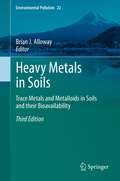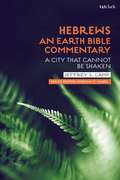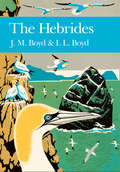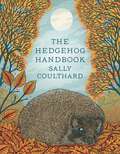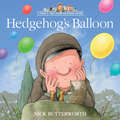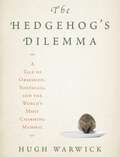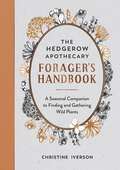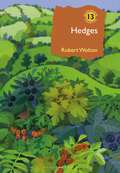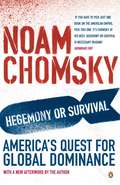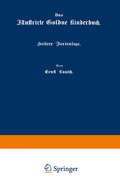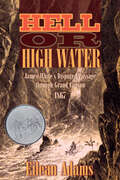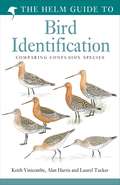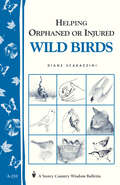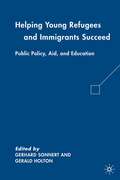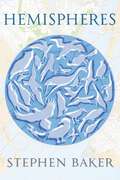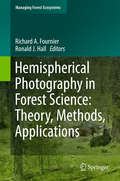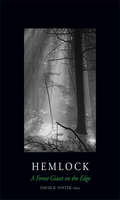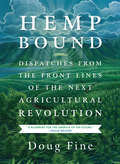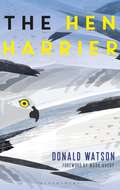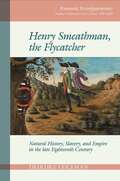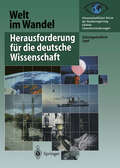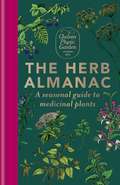- Table View
- List View
Heavy Metals in Soils: Trace Metals and Metalloids in Soils and their Bioavailability (Environmental Pollution #22)
by Brian J. AllowayThis third edition of the book has been completely re-written, providing a wider scope and enhanced coverage. It covers the general principles of the natural occurrence, pollution sources, chemical analysis, soil chemical behaviour and soil-plant-animal relationships of heavy metals and metalloids, followed by a detailed coverage of 21 individual elements, including: antimony, arsenic, barium, cadmium, chromium, cobalt, copper, gold, lead, manganese, mercury, molybdenum, nickel, selenium, silver, thallium, tin, tungsten, uranium, vanadium and zinc. The book is highly relevant for those involved in environmental science, soil science, geochemistry, agronomy, environmental health, and environmental engineering, including specialists responsible for the management and clean-up of contaminated land.
Hebrews: A City That Cannot Be Shaken (Earth Bible Commentary)
by Jeffrey S. LampIn this new ecological commentary on the letter to the Hebrews, Jeffrey S. Lamp makes use of approaches developed in the relatively new field of Ecological Hermeneutics to shed light upon the connection of Hebrews with Earth.Hebrews is frequently characterized as portraying a dualistic cosmology that diminishes the material world, muting the voice of Earth. Conversely, Lamp argues that though Hebrews cannot be construed as an ecological treatise, the contours of the letter's presentation may be subverted by reading from an ecological perspective, such that cues provided by the author of Hebrews serve as opportunities to hear Earth's voice in the letter. Three movements, corresponding to thematic interests of the author of Hebrews, form the framework of this ecological reading: the Son as the agent of creation, the Son depicted as the Second Adam, and the New Jerusalem as the eschatological dwelling place of God. This ecological reading of Hebrews aims to shape its readers into those who fulfill the soteriological aims of God in and for the world.
Hebrews: A City That Cannot Be Shaken (Earth Bible Commentary)
by Jeffrey S. LampIn this new ecological commentary on the letter to the Hebrews, Jeffrey S. Lamp makes use of approaches developed in the relatively new field of Ecological Hermeneutics to shed light upon the connection of Hebrews with Earth.Hebrews is frequently characterized as portraying a dualistic cosmology that diminishes the material world, muting the voice of Earth. Conversely, Lamp argues that though Hebrews cannot be construed as an ecological treatise, the contours of the letter's presentation may be subverted by reading from an ecological perspective, such that cues provided by the author of Hebrews serve as opportunities to hear Earth's voice in the letter. Three movements, corresponding to thematic interests of the author of Hebrews, form the framework of this ecological reading: the Son as the agent of creation, the Son depicted as the Second Adam, and the New Jerusalem as the eschatological dwelling place of God. This ecological reading of Hebrews aims to shape its readers into those who fulfill the soteriological aims of God in and for the world.
The Hebrides (Collins New Naturalist Library #76)
by J. M. Boyd I. L. BoydA complete natural history of the Hebrides – an area of great natural beauty, which draws back thousands of visitors year after year to its wonderful scenery and abundant wildlife.
The Hedgehog Handbook
by Sally Coulthard'Wonderful' Yorkshire Times'Not just a celebration of these enigmatic creatures, but also a timely alarm bell about their shrinking numbers' The Lady'Just about every hedgehog fact you could wish to know' Northern EchoHedgehogs, with their quiet determination and bristling, bumbling ways, are one of the most enduring symbols of the countryside and town gardens. The Hedgehog Handbook explores different facets of this enigmatic and much-admired mammal – from its eating and sleeping habits to its literary heritage and how we can help preserve this icon of rural life. Packed with inspirational quotes, entertaining facts, folklore and literary references, it's the perfect gift for anyone with a penchant for prickles.
Hedgehog’s Balloon (A Percy the Park Keeper Story)
by Nick ButterworthA funny Percy the Park Keeper story from highly regarded, award-winning author and illustrator Nick Butterworth, creator of One Snowy Night.
The Hedgehog's Dilemma: A Tale of Obsession, Nostalgia, and the World's Most Charming Mammal
by Hugh WarwickIn this wonderfully entertaining, adorable book, Hugh Warwick, an environmental writer and photographer, examines the relationship between the hedgehog and man, and how the hedgehog became so beloved. Traveling the globe in search of his quarry, Warwick eventually discovers a new breed called Hugh's Hedgehog.
The Hedgerow Apothecary Forager's Handbook: A Seasonal Companion to Finding and Gathering Wild Plants
by Christine IversonLearn to forage in the hedgerows like the herbalists of the pastAs many of us look for ways to live a more planet-friendly lifestyle, the sustainable and ethical art of foraging offers us a way to connect with the world around us. It is a practice rich in tradition and steeped in history, and one that links us to our past and our future.This foraging companion is designed to be taken with you on your adventures into the hedgerows, forests and woodland all year round. Helpfully arranged by season, this book includes clear photographs to aid plant identification, ideas on how best to prepare and preserve your finds, fascinating foraging and plant folklore, and handy pages to make your own notes and drawings.Additional features:Paperback and lightweight (approx. 330g) design, to allow you to take the book with you while foragingA month-by-month foraging calendarAdvice on foraging etiquette and tips for creating a forager’s toolkitThis is the essential guide to enjoying the bountiful delights of the hedgerows.
Hedges (British Wildlife Collection)
by Robert WoltonAn absorbing celebration of the ecology, biology and cultural history of the rich hedgerow heritage in the British Isles.Much of the UK is intensively farmed, and in such landscapes hedges are often the only refuge for wildlife. In addition to providing shelter, protection and food for animals, they also connect and bind together the patches of habitat that do remain, as well as playing vital roles in soil conservation and flood prevention – in short, they are vital for nature's recovery.In Hedges, Robert Wolton brings together decades of research, while also incorporating personal experiences from his farm in Devon, to explore the ecology, nature conservation and wider environmental values of our hedges. From improving water quality and producing wood fuel as a renewable energy source to the use of hedges in boosting crop pollination, this engaging and authoritative book will help to inspire people to value and look after the remarkably rich hedgerow heritage we have in the British Isles.Containing more than 300 photographs and figures, this latest addition to the British Wildlife Collection is a comprehensive commentary on hedges and our relationship with them.
Hedges (British Wildlife Collection)
by Robert WoltonAn absorbing celebration of the ecology, biology and cultural history of the rich hedgerow heritage in the British Isles.Much of the UK is intensively farmed, and in such landscapes hedges are often the only refuge for wildlife. In addition to providing shelter, protection and food for animals, they also connect and bind together the patches of habitat that do remain, as well as playing vital roles in soil conservation and flood prevention – in short, they are vital for nature's recovery.In Hedges, Robert Wolton brings together decades of research, while also incorporating personal experiences from his farm in Devon, to explore the ecology, nature conservation and wider environmental values of our hedges. From improving water quality and producing wood fuel as a renewable energy source to the use of hedges in boosting crop pollination, this engaging and authoritative book will help to inspire people to value and look after the remarkably rich hedgerow heritage we have in the British Isles.Containing more than 300 photographs and figures, this latest addition to the British Wildlife Collection is a comprehensive commentary on hedges and our relationship with them.
Hegemony or Survival: America's Quest for Global Dominance (American Empire Project Ser. #Vol. 185)
by Noam ChomskyHegemony or Survival is Noam Chomsky's essential polemic on American foreign policy.Noam Chomsky, the world's foremost intellectual activist, presents an irrefutable analysis of America's pursuit of total domination and the catastrophic consequences that are sure to follow.From the funding of repressive regimes to the current 'war on terror', from the toppling of governments opposing its beliefs to the invasion of Iraq, America pursues its global strategy no matter what the cost. With the rigour and insight that have made him our most important unraveller of accredited lies, Noam Chomsky reveals the truth and the true motives behind America's quest for dominance - and seeks also to show how the world may yet step back from the brink.'A devastating history of American foreign policy since 1945 as well as a dissection of the current "war on terror"' Tim Adams, Observer'Anybody who thinks about American foreign policy has to read and contemplate Hegemony or Survival' Independent'One of the radical heroes of our age. A towering intellect' GuardianNoam Chomsky is the author of numerous bestselling political books, including Hegemony or Survival, Failed States, Interventions, What We Say Goes, Hopes and Prospects, How the World Works and Occupy, all of which are published by Hamish Hamilton/Penguin.
Hell Or High Water: James White's Disputed Passage through Grand Canyon, 1867 (G - Reference, Information And Interdisciplinary Subjects Ser.)
by Eilean AdamsAlthough John Wesley Powell and party are usually given credit for the first river descent through the Grand Canyon, the ghost of James White has haunted those claims. White was a Colorado prospector, who, almost two years before Powell's journey, washed up on a makeshift raft at Callville, Nevada. His claim to have entered the Colorado above the San Juan River with another man (soon drowned) as they fled from Indians was widely disseminated and believed for a time, but Powell and his successors on the river publically discounted it. Colorado River runners and historians have since debated whether White's passage through Grand Canyon even could have happened. Hell or High Water is the first full account of White's story and how it became distorted and he disparaged over time. It is also a fascinating detective story, recounting how White's granddaughter, Eilean Adams, over decades and with the assistance of a couple of notable Colorado River historians who believed he could have done what he claimed, gradually uncovered the record of James White's adventure and put together a plausible narrative of how and why he ended up floating helplessly down a turbulent river, entrenched in massive cliffs, with nothing but a driftwood raft to carry him through.
The Helm Guide to Bird Identification
by Keith Vinicombe Alan HarrisThis book covers difficult identification issues by looking at tricky species pairs or groups of birds, and comparing and contrasting their respective features. Designed as a field companion, it supplements the standard field guides and provides much additional information. As well as detailed texts, the books include extensive illustrations of all relevant ages and plumages of the species concerned.
The Helm Guide to Bird Identification
by Keith Vinicombe Alan HarrisThis ebook covers difficult identification issues by looking at tricky species pairs or groups of birds, and comparing and contrasting their respective features. Designed as a field companion, it supplements the standard field guides and provides much additional information. As well as detailed texts, the books include extensive illustrations of all relevant ages and plumages of the species concerned.
Helping Orphaned or Injured Wild Birds: Storey's Country Wisdom Bulletin A-210 (Storey Country Wisdom Bulletin)
by Diane ScarazziniTo Help or Not to Help? When faced with an injured bird or orphaned nestling, most people want to help but don’t know how – and also fear doing more harm than good. In fact, many wild birds that appear to be in trouble don’t need assistance at all. How do you know whether a bird needs help? How do you know what sort of help the bird needs? In Helping Orphaned or Injured Wild Birds, you’ll find all the information you need on when and how to assist all kinds of birds, from wrens to raptors. You’ll learn how to: Identify whether a bird needs rescuingHelp a baby bird that’s fallen from its nestIdentify the age and species of an injured of orphaned birdPrepare emergency rations for a baby birdAdminister basic bird first-aid Locate a professional wildlife rehabilitator
Helping Young Refugees and Immigrants Succeed: Public Policy, Aid, and Education
by G. HoltonIn a unique effort, this book brings together, for the first time, scholarly analyses by eminent researchers of the historical, social, legal, and cultural influences on the young newcomers' lives as well as reports by practitioners in major aid organizations about the concrete work that their organizations have been carrying out.
Hemispheres: A Novel Of Family, Birds And Coming Home
by Stephen BakerSHORTLISTED FOR THE 2011 EAST MIDLANDS BOOK AWARDMoving from the gas-flares of Teesside, to marine adventures in the South Atlantic, Hemispheres is a salutary and searing debut novel for anyone who enjoyed Kes and The Northern Clemency.When sixteen-year-old Danny's father, Yan, leaves their Teesside home to fight in the Falklands War, he never returns and Danny imagines he is either dead or has abandoned him and his mother for good. So when, thirty years later, Yan reappears, there is much to be explained, and forgiven, if father and son are to reconcile their broken relationship. Yan has spent the lost years half a world away, adrift on a remarkable chain of adventures set in motion when he deserted from the army. But when he discovers he is dying from lung cancer, he returns to his homeland in the north-east of England to reconcile his damaged relationship with his son. Separated by years and experience, father and son find unexpected solace and harmony together through their shared love of birds and birdwatching. Hemispheres is a gloriously ambitious debut novel about family, destiny, nature and coming home.
Hemispherical Photography in Forest Science: Theory, Methods, Applications (Managing Forest Ecosystems #28)
by Richard A. Fournier Ronald J. HallThis book presents practical information about hemispherical photography from the perspectives of field data acquisition, image processing and information retrieval methods. This book is organized into three sections. The first section describes what is hemispherical photography and what are the fundamental elements of forest structure and light interactions within the forest canopy. The second section provides practical information about the equipment, procedures and tools for procuring, processing and analyzing hemispherical photographs. Armed with this information, the third section describes several applications of hemispherical photographs to forestry and natural resource assessment. The book concludes with a discussion about modelling tools and future directions of this rapidly growing field. There is currently no information source on the market that has this comprehensive range of topics combined in a single book. The book will appeal to academics, graduate students, natural resource professionals and researchers alike.
Hemlock: A Forest Giant on the Edge
by Anthony D'Amato Benjamin Baiser Aaron M. Ellison David Orwig Wyatt Oswald Audrey Barker Plotkin Jonathan ThompsonThe Eastern Hemlock, massive and majestic, has played a unique role in structuring northeastern forest environments, from Nova Scotia to Wisconsin and through the Appalachian Mountains to North Carolina, Tennessee, and Alabama. A “foundation species” influencing all the species in the ecosystem surrounding it, this iconic North American tree has long inspired poets and artists as well as naturalists and scientists. Five thousand years ago, the hemlock collapsed as a result of abrupt global climate change. Now this iconic tree faces extinction once again because of an invasive insect, the hemlock woolly adelgid. Drawing from a century of studies at Harvard University’s Harvard Forest, one of the most well-regarded long-term ecological research programs in North America, the authors explore what hemlock’s modern decline can tell us about the challenges facing nature and society in an era of habitat changes and fragmentation, as well as global change.
Hemp Bound: Dispatches from the Front Lines of the Next Agricultural Revolution
by Doug FineThe stat sheet on hemp sounds almost too good to be true: its fibers are among the planet’s strongest, its seed oil the most nutritious, and its potential as an energy source vast and untapped. Its one downside? For nearly a century, it’s been illegal to grow industrial cannabis in the United States–even though Betsy Ross wove the nation’s first flag out of hemp fabric, Thomas Jefferson composed the Declaration of Independence on it, and colonists could pay their taxes with it. But as the prohibition on hemp’s psychoactive cousin winds down, one of humanity’s longest-utilized plants is about to be reincorporated into the American economy. Get ready for the newest billion-dollar industry. In Hemp Bound:Dispatches from the Front Lines of the Next Agricultural Revolution, bestselling author Doug Fine embarks on a humorous yet rigorous journey to meet the men and women who are testing, researching, and pioneering hemp’s applications for the twenty-first century. From Denver, where Fine hitches a ride in a hemp-powered limo; to Asheville, North Carolina, where carbon-negative hempcrete-insulated houses are sparking a mini housing boom; to Manitoba where he raps his knuckles on the hood of a hemp tractor; and finally to the fields of east Colorado, where practical farmers are looking toward hemp to restore their agricultural economy—Fine learns how eminently possible it is for this misunderstood plant to help us end dependence on fossil fuels, heal farm soils damaged after a century of growing monocultures, and bring even more taxable revenue into the economy than its smokable relative. Fine’s journey will not only leave you wondering why we ever stopped cultivating this miracle crop, it will fire you up to sow a field of it for yourself, for the nation’s economy, and for the planet.
The Hen Harrier (Poyser Monographs #86)
by Donald WatsonAn acknowledged classic of narrative nature-writing, Donald Watson's The Hen Harrier was the culmination of a lifetime's study of this beautiful upland bird. A gentle, warm and wonderfully written book, The Hen Harrier stems from an age of 'amateur' conservation, from the pen of a man who cared deeply about birds and their habitats, especially of the Scottish borders where he conducted much of his research and painting. The book was among the last of a dying breed; it would be thirty years or more before writing on our natural history would again reach the heights of accessibility to nature-lovers exemplified by Donald Watson and his peers. The book starts with Watson setting down more or less everything known about harriers – which at that time often consisted of information sent by letter to the author, rather than published in a journal – before moving on to the story of Watson's years studying nests in the south-west of Scotland.With a foreword by conservation champion Mark Avery, this edition of Watson's greatest work is particularly timely. The conflict between grouse-shooting interests, which has overseen the virtual extinction of the harrier as a breeding bird in England through illegal persecution, and an increasingly vocal conservationist lobby is the number one conservation issue in Britain today.Donald Watson's narrative soars like a sky-dancing harrier throughout this book. Read it, and be taken back to a simpler age of nature conservation by a true master of the art.
Henry Smeathman, the Flycatcher: Natural History, Slavery, and Empire in the Late Eighteenth Century (Romantic Reconfigurations: Studies in Literature and Culture 1780-1850 #2)
by Deirdre ColemanIn 1771 Joseph Banks and other wealthy collectors sent a talented, self-taught naturalist to Sierra Leone to collect all things rare and curious, from moths to monkeys. Henry Smeathman’s expedition to the West African coast, which coincided with a steep rise in British slave trading in this area, lasted four years during which time he built a house on the Banana Islands, married into the coast’s ruling dynasties, and managed to negotiate the tricky life of a ‘stranger’ bound to his landlord and local customs. In this book, which draws on a rich and little-known archive of journals and letters, Coleman retraces Smeathman’s life as he shuttled between his home on the Bananas and two key Liverpool trading forts—Bunce Island and the Isles de Los. In the logistical challenges of tropical collecting and the dispatch of specimens across the middle passage we see the close connection between science and slavery. We also see the hardening of Smeathman’s attitude towards the slaves, a change of sentiment which was later reversed by four years in the West Indies. The book concludes with the 'Flycatcher' back in London - a celebrated termite specialist, eager to return to West Africa to establish a free, antislavery settlement.
Herausforderung für die deutsche Wissenschaft: Jahresgutachten 1996 (Welt im Wandel #1996)
by Wissenschaftlicher Beirat Wissenschaftlicher Beirat GlobaleUmweltveränderungenDer Wissenschaftliche Beirat der Bundesregierung Globale Umweltveränderungen (WBGU) bemängelt in seinem neuesten Jahresbericht, daß die deutsche Forschung zum Globalen Wandel zu wenig international ausgerichtet, zu stark an Einzeldisziplinen orientiert und in der politikrelevanten Aufbereitung zu schwach entwickelt ist. Als Alternative werden neue Möglichkeiten zu Strukturveränderungen in der Forschungslandschaft aufgezeigt. Dazu hat das Expertengremium einen neuen Ansatz zur Erforschung des Globalen Wandels vorgelegt: den Syndromansatz. Hiermit können die "Erkrankungen" des Planeten Erde systematisch beschrieben und analysiert werden, mit dem Ziel, Lösungsansätze zu entwickeln. Die 16 wichtigsten Syndrome oder Krankheitsbilder der Erde wurden identifiziert.
The Herb Almanac: A seasonal guide to medicinal plants
by Chelsea Physic GardenA beautiful and accessible seasonal guide to herbalism from the historic botanic garden.Discover the best times of the year for growing specific healing herbs and also when and how to forage for wild medicine, such as water mint, St John's Wort, hawthorn berries and rosehips. Recipes are included for how to use these herbs, along with folklore stories from herb wives and hedge witches, the meanings behind their names and the history of how these natural medicines were discovered.There are plenty of tips for how to create your own medicinal herb garden, even with just a few pots, along with a biodynamic guide for sowing, planting and harvesting. Including detailed hand-drawn line illustrations to help deepen your understanding, The Herb Almanac is the perfect gift for any nature lover.CONTENTS INCLUDES:IntroductionIncluding using herbs as seasonally appropriate remedies and tonics, an overview of herbs in folklore, wild medicine, magic, superstition, ritual, tradition and literature and herbs in religion and floriography (the language of flowers)Gathering and Using HerbsIncluding safe, legal and successful foraging, a brief introduction to growing your own herbs and preparing, drying and preserving herbsWitches' Brews: Poisonous Plants Including an overview of herbs with interesting stories that cannot be easily used, e.g. wormwood, hemlock and mandrakeHerb EncyclopediaIncluding detailed information on over 50 different herbs
